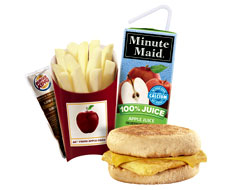Twenty- or 30-odd years ago, before society as a whole was fully attuned to the hazards—physical and moral—of allowing kids to eat pretty much whatever they wanted, whenever they wanted, product development was a relative snap.
In the 1960s, ’70s, and ’80s, it was pretty easy to figure out a way to get kids interested from a culinary standpoint. It mostly came down to pandering: burgers, pizza, hot dogs, lots of deep-fried chicken, fish, and potatoes. It was the typical high-calorie, high-fat kiddie fare that still constitutes the core of kids’ menus at thousands of restaurants nationwide.
But as kids began growing out even faster than they grew up, and as the American palate began to get a bit more adventurous, kid-friendly dining began to evolve. That’s not just nutritionally speaking, but also in terms of sophistication, variety, and customization. Here is a brief primer for developing kid-friendly, parent-approved menu items in 2011 and beyond. Not specific solutions, but more of a quick guide for your product developers and marketing counterparts.
Step 1: Make it Healthy
At the risk of sounding like a soapbox preacher, I would suggest that we can no longer question whether quick-serve operators bear any obligation to help address the childhood-obesity epidemic. Many or most chains—from Starbucks to Burger King to Taco Bell—have owned up to this responsibility, either tacitly or explicitly, by broadening their array of healthful offerings. And those that haven’t yet seen fit to jump on the fitter-kids bandwagon are facing plenty of pressure from some pretty powerful influencers. First Lady Michelle Obama, celebrity chef Jamie Oliver, and activist author Michael Pollan are turning up the heat on restaurateurs and consumer packaged-goods companies. Mrs. Obama’s “Let’s Move!” campaign has even gone so far as to suggest that mayors and city officials nationwide restrict the sale of fast food in areas near schools.
And let’s not forget the pressure being exerted by parents themselves. About 40 percent of parent respondents to a 2009 survey conducted by the research firm Technomic indicated they would have a negative perception of restaurants that did not offer healthful kids’ meals.
But in an era of fad diets, quick fixes, and competing or contradictory health claims, what exactly is healthy nowadays? From my vantage point, there are four real levers that chains can pull: freshness, natural/organic, whole grains, and cooking technique. Including more fresh fruits and vegetables in everyday offerings, increasing the number and variety of whole grains and natural/organic ingredients on the menu, and ramping up the number of available grilled, roasted, and broiled items could go a long way toward bolstering chains’ health bona fides.
Step 2: Up the Sophistication
One of the terrific fringe benefits of a multiethnic, multicultural society is the exposure our kids are getting to new and exciting flavors that were utterly foreign to most young Americans as recently as 15 or 20 years ago.
My own five-year-old daughter is positively crazy for sushi; other kids on our block are every bit as excited about authentic Mexican and Thai fare. As Pam Abrams, author of Gadgetology: Kitchen Fun with Your Kids, told the New York Times in 2007, “The popularity of ethnic food has expanded kids’ palates.”
For quick-serve operators intent on offering kids something novel and distinctive, this scenario opens up a world of possibilities. Whereas the idea of offering exotic but highly approachable foods such as Indian samosas, Salvadoran papusas, Venezuelan arepas, and Mexican empanadas might have seemed far too esoteric for a fast food menu years ago, today it’s entirely possible to imagine any or all of these treats on a typical American menu.
All of which is to say that there’s no longer any need for an Asian- or Mexican-themed chain to try offering kids a menu consisting of hot dogs, grilled cheese, and peanut butter and jelly sandwiches. Kids today are much more interested in exploring authentic and unusual flavors, and operators can capitalize on this trend with some interesting explorations of their own.
Step 3: Think Fun, Interactive, Customizable
“Playing with your food,” once verboten, is now sanctioned by many parents and the chains that cater to their children. Chipotle’s interactive taco kit, in which kids customize their tacos with any of several meat, vegetable, and condiment options, is a prime example of making food more fun. The same goes for Uno Chicago Grill’s “make your own pizza” program, in which kids get an apron, thin-crust pizza dough, sauce, and toppings to do with as they please. Edible entertainment is, in many ways, the order of the day, and it can help make kid-friendly chains a frequent fixture of parents’ dining-out routines as well.
Developing desirable menu options for kids is at once more complicated and far simpler than it’s ever been. It’s simpler because kids’ more sophisticated palates open doors to a wealth of interesting ethnic possibilities. But the task is also more complicated than ever because kids today are harder to impress, and because their parents are much more demanding, particularly when it comes to the products’ nutritional profiles. But by taking into account the three key guideposts noted above, I feel certain fast food chains can rewrite the book on kids’ menus, and drive transaction and same-store sales growth in the process.











